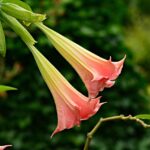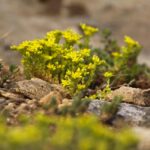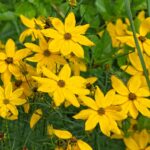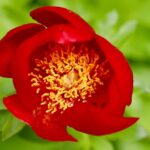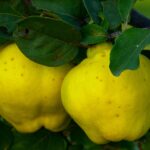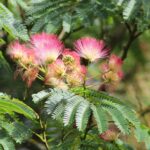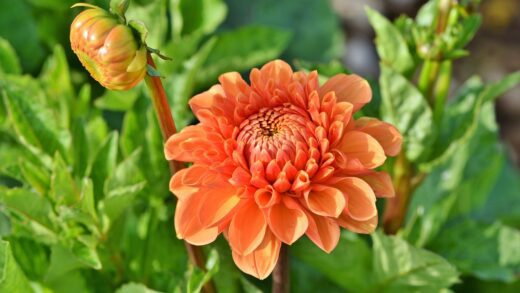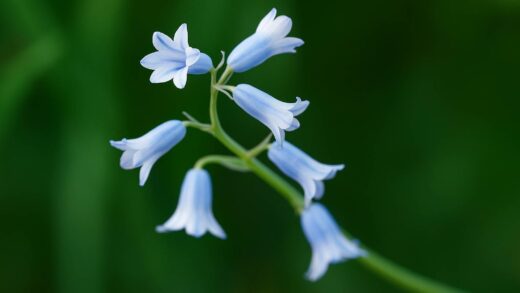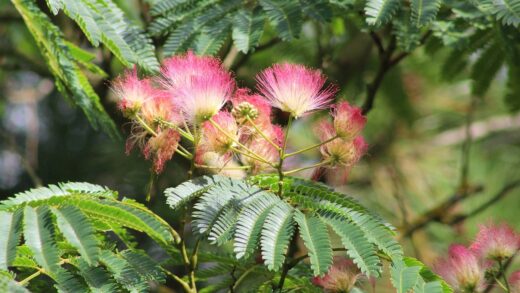Successfully establishing an Asian persimmon tree begins long before the sapling is placed in the ground; it starts with careful planning and an understanding of the tree’s fundamental requirements. The process of planting and propagation is a critical first step that dictates the future health, vigor, and productivity of the tree. From selecting the right variety for your climate to mastering the techniques of grafting or seed germination, each stage requires attention to detail. A well-executed planting provides the foundation for a strong root system, while skillful propagation allows for the continuation of desirable genetic traits, ensuring a legacy of delicious fruit for years to come.
The journey to a fruitful persimmon tree starts with the crucial decision of which variety to plant. Asian persimmons are generally divided into two main categories: astringent and non-astringent. Non-astringent types, such as the popular ‘Fuyu’ and ‘Jiro’, can be eaten while still firm and crisp, offering a sweet, mild flavor. Astringent varieties, like ‘Hachiya’ and ‘Saijo’, contain high levels of tannins when firm and must be allowed to soften to a jelly-like consistency before they are palatable. Consideration of local climate, desired fruit characteristics, and pollination requirements is paramount when making this selection.
Once a variety has been chosen, the next step is to acquire a healthy young tree from a reputable nursery. It is best to select a bare-root or container-grown tree that is one to two years old, as these tend to establish more quickly than older, larger trees. Inspect the tree carefully for any signs of disease, pests, or physical damage. The root system should be well-developed and healthy-looking, not pot-bound or dried out. A strong central leader and a good branching structure are also indicators of a quality sapling that has been well cared for.
The timing of planting is another critical factor for success. The ideal time to plant a persimmon tree is during its dormant period, either in the late fall after the leaves have dropped or in the early spring before new growth begins. Planting during dormancy minimizes transplant shock, allowing the tree’s root system to begin establishing itself in the new location before it needs to support the energy demands of leaf and shoot production. This gives the tree a significant head start, leading to more vigorous growth in its first season.
Choosing the right persimmon variety
Choosing the appropriate persimmon variety is a foundational decision that will influence the entire cultivation experience. The first major distinction to understand is between astringent and non-astringent types. Non-astringent persimmons lose their tannins early, allowing them to be eaten while crisp like an apple, which many growers find convenient. In contrast, astringent varieties offer a rich, complex sweetness but only after they have fully ripened to a soft, almost gelatinous texture. Your personal preference for fruit texture and the intended use of the fruit should guide this initial choice.
More articles on this topic
Beyond astringency, cold hardiness is a critical trait to consider, especially in regions with cold winters. While Asian persimmons are generally less cold-hardy than their American counterparts, there is significant variation among cultivars. Varieties such as ‘Saijo’ and ‘Sheng’ are known to have better cold tolerance than others like ‘Fuyu’. Researching varieties that are proven to perform well in your specific climate zone is essential to avoid winter injury or tree loss. Consulting with local agricultural extension services or experienced growers in your area can provide invaluable, region-specific recommendations.
Pollination requirements are another important factor in variety selection. Many Asian persimmon varieties are parthenocarpic, meaning they can set fruit without pollination, resulting in seedless fruit. However, some varieties produce a heavier and more consistent crop when a pollinizer is present. Furthermore, some cultivars are designated as pollination-constant (their flesh color is unaffected by pollination), while others are pollination-variant (the flesh around the seeds becomes dark and speckled when pollinated). Understanding these characteristics is key to managing your orchard and achieving the desired fruit quality.
Finally, consider the tree’s growth habit, size, and ripening time. Some varieties grow into large, spreading trees, while others have a more compact or upright form, making them better suited for smaller gardens. The ripening season also varies, with some cultivars producing fruit in early autumn and others ripening much later. Selecting a variety that fits your available space and whose harvest window aligns with your climate’s first frost date ensures that you can enjoy a full, ripened crop each year.
Site preparation and planting process
Thorough site preparation is essential to give your Asian persimmon tree the best possible start. Begin by selecting a location that receives at least six hours of direct sunlight daily. The soil should be deep and well-drained with a slightly acidic to neutral pH. Before digging, clear a wide area, at least one meter in diameter, of all grass and weeds that would compete with the young tree for water and nutrients. This initial clearing creates a competition-free zone that is crucial for the tree’s early establishment and growth.
More articles on this topic
The next step is to prepare the planting hole, which should be significantly wider than it is deep. A common mistake is to dig a deep hole and amend the backfill soil heavily, which can create a “pot” effect, discouraging roots from growing out into the native soil. Instead, dig the hole two to three times as wide as the tree’s root ball but no deeper than the root ball itself. The goal is to have the tree sit on a solid base of undisturbed soil, with its root flare—the point where the roots begin to branch from the trunk—sitting at or slightly above the surrounding ground level.
When you are ready to plant, carefully remove the tree from its container or unwrap the roots of a bare-root tree. Gently inspect the root system and prune away any broken, circling, or damaged roots. Place the tree in the center of the prepared hole, ensuring it is positioned vertically. Begin backfilling the hole with the native soil that was originally excavated. It is generally not recommended to add large amounts of compost or fertilizer directly into the planting hole, as this can hinder the roots’ outward expansion into the less-amended native soil.
After backfilling the hole about halfway, gently water the soil to help it settle and remove any air pockets around the roots. Finish filling the hole, and then create a shallow basin or “berm” of soil around the outer edge of the planting area. This basin will help to retain water and direct it down to the root zone during irrigation. Water the newly planted tree thoroughly once more, and then apply a layer of organic mulch around the base, keeping it a few centimeters away from the trunk to prevent moisture buildup and potential rot.
Propagation through grafting
Grafting is the most common and reliable method for propagating Asian persimmon trees, as it ensures that the new tree is a true genetic clone of the desired parent variety. This technique involves joining a piece of scion wood (a cutting from the desired variety) onto a compatible rootstock. The rootstock provides the root system and is typically chosen for its adaptability to specific soil conditions or its cold hardiness. Diospyros virginiana (American persimmon) and Diospyros lotus (date-plum) are commonly used rootstocks for Asian persimmon cultivars.
The success of grafting depends heavily on proper timing and technique. The ideal time to graft persimmons is in the spring, just as the rootstock is beginning to show signs of active growth, such as swelling buds. The scion wood, however, should be collected during the dormant season (mid-winter) and kept cool and moist to ensure it remains fully dormant until it is used. This difference in physiological state is crucial, as it encourages the rootstock to direct its energy into healing the graft union before the scion begins to grow.
Several grafting techniques can be used for persimmons, but the whip-and-tongue graft and the cleft graft are among the most popular and effective. The whip-and-tongue method is ideal for scions and rootstocks of a similar diameter, creating a large area of cambial contact that promotes rapid healing. The cleft graft is more suitable when the rootstock is significantly larger than the scion wood. In both methods, it is imperative that the cambium layers—the thin green layer just beneath the bark—of both the scion and the rootstock are perfectly aligned, as this is where the vascular tissues will connect and grow together.
After the graft has been made, it must be secured and protected to ensure a successful union. The graft site should be wrapped tightly with grafting tape or rubber bands to hold the scion and rootstock firmly together and maintain cambial contact. The entire union, including the cut tip of the scion, should then be sealed with grafting wax or a sealant to prevent it from drying out and to protect it from water and potential pathogens. With proper care and a bit of patience, the scion will begin to grow within a few weeks, creating a new tree with the desired fruit characteristics.
Propagation from seeds
Propagating Asian persimmons from seed is a fascinating process, but it is important to understand that the resulting trees will not be true to the parent variety. Due to genetic variability, a tree grown from a ‘Fuyu’ seed, for example, will produce fruit that is different from a ‘Fuyu’ persimmon, and its quality is unpredictable. Therefore, growing from seed is typically done for the purpose of cultivating rootstock for grafting or simply as an experimental and educational endeavor for the patient gardener.
The first step in seed propagation is to collect seeds from fully ripe persimmon fruit. Clean the seeds thoroughly, removing all fruit pulp, as the pulp contains germination inhibitors. Once cleaned, the seeds require a period of cold, moist stratification to break their natural dormancy. This process mimics the natural winter conditions that the seeds would experience outdoors. To stratify the seeds, mix them with a slightly damp medium like sand, peat moss, or vermiculite, place the mixture in a sealed plastic bag or container, and store it in a refrigerator for a period of two to three months.
After the stratification period, the seeds are ready for planting. They can be sown in deep pots or seed trays filled with a well-draining potting mix. Plant the seeds about two centimeters deep and keep the soil consistently moist but not saturated. Place the containers in a warm location, as germination is often more successful with gentle bottom heat. Germination can be slow and erratic, sometimes taking several weeks or even months, so patience is essential during this stage.
Once the seedlings have germinated and developed a few sets of true leaves, they can be carefully transplanted into individual, deeper pots to accommodate their long taproots. It is crucial to handle the seedlings gently to avoid damaging the delicate root system. Continue to grow them in a protected environment until they are large and strong enough to be planted outdoors. These seedling trees can then be allowed to grow on their own to see what kind of fruit they produce, or they can be used as rootstock onto which a known, desirable cultivar can be grafted.
Initial care for young trees
The first few years in the life of an Asian persimmon tree are a critical period that sets the foundation for its future health and productivity. During this establishment phase, the primary goal is to encourage the development of a strong, deep root system and a well-structured scaffold of branches. Consistent and proper care during this time will result in a tree that is more resilient to environmental stresses, such as drought and winter cold, and more capable of bearing a heavy crop load in the future.
Watering is the most important aspect of care for a young persimmon tree. The root ball must be kept consistently moist, but not waterlogged, throughout the first two growing seasons. Deep, infrequent watering is more effective than shallow, frequent applications, as it encourages the roots to grow downwards in search of moisture. Applying a thick layer of organic mulch around the base of the tree is highly beneficial, as it helps to conserve soil moisture, regulate soil temperature, and suppress weeds that compete for resources.
Fertilization should be approached with caution during the first year. A newly planted tree needs to focus its energy on root establishment, and excessive nitrogen can force weak, leafy growth at the expense of root development. It is often best to forgo fertilizing in the first year altogether, especially if the soil was well-prepared with organic matter before planting. In the second year, a light application of a balanced, slow-release fertilizer formulated for fruit trees can be applied in the spring as new growth begins.
Formative pruning is also essential during the initial years to establish a strong and open framework. In the first dormant season after planting, select three to five well-spaced branches to become the main scaffold limbs and remove any others that are poorly positioned, weak, or competing with the central leader. This early structural training prevents problems such as weak crotches and crossing branches later on, and it ensures good light penetration and air circulation throughout the canopy, which is vital for fruit quality and disease prevention.











